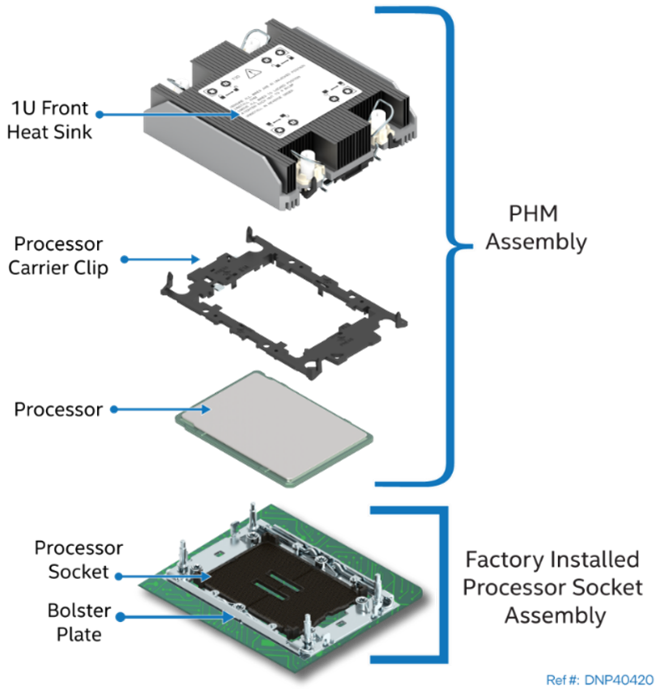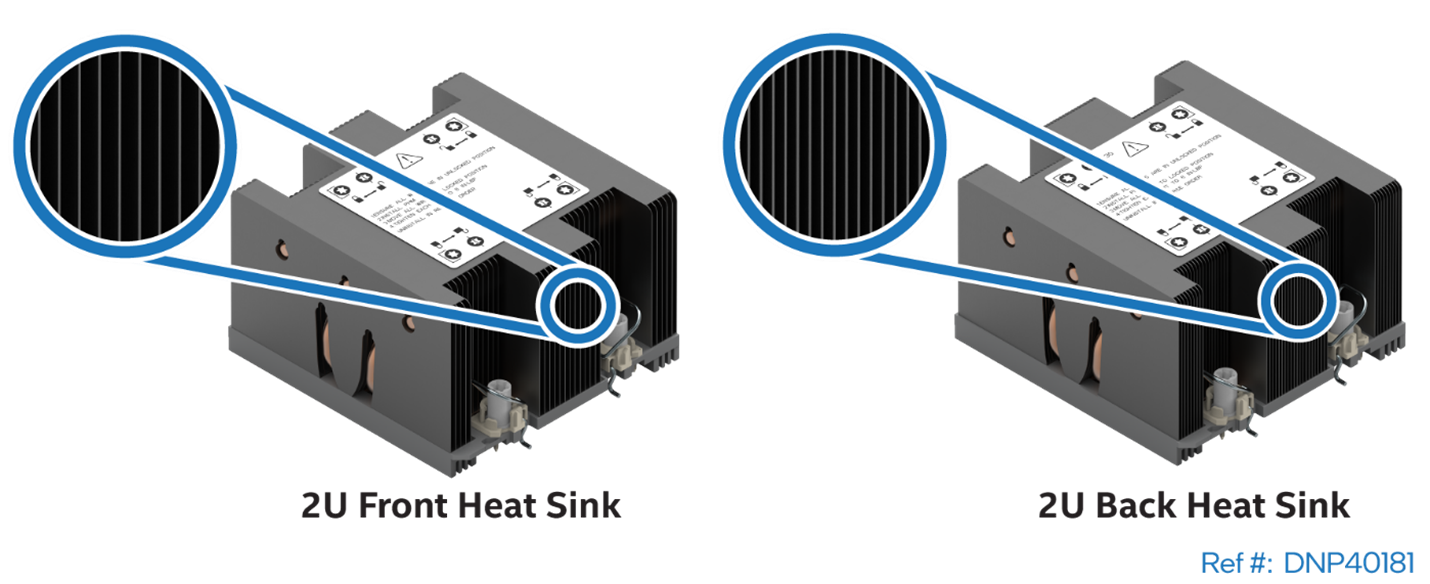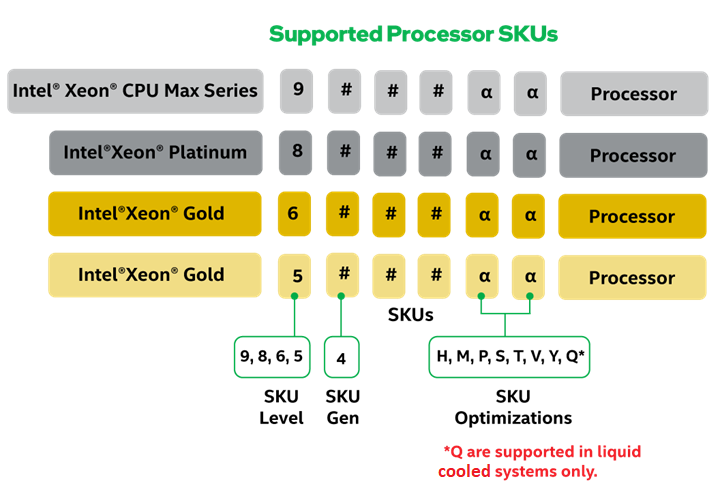Processor Support for Intel® Server D50DNP Family
As part of the Intel® Server D50DNP Family, the Intel® Server Board D50DNP1SB includes two E LGA4677 processor sockets compatible with the 4th Gen Intel® Xeon® Scalable processors family or Intel® Xeon® CPU Max Series processors. This chapter provides information on processor heat sinks, thermal design power (TDP), and population rules. The chapter also provides a processor family overview.
This article provides information on processor heat sinks, thermal design power (TDP), and population rules, including a processor family overview.
| Note | Previous-generation Intel® Xeon® Processors and Intel® Xeon® Scalable Processor families and their supported processor heat sinks are not compatible with server boards described in this document. |
Processor Cooling Overview
The server board includes two processor socket assemblies, each consisting of a processor socket and bolster plate. The factory-installed bolster plate is secured to the server board and is used to align the processor cooling hardware over the processor socket and secure it to the server board.
Processor cooling options in a server system may use a passive heat sink that use airflow to dissipate heat generated by the processors. Other processor cooling options may use liquid cooling plates, where cool liquid is pumped through the cooling plates to absorb the heat from the processor.
For air-cooled systems, the processor and heat sink are generally preassembled into a single processor heat sink module (PHM) before being installed onto the processor socket assembly.
The PHM concept reduces the risk of damaging pins in the processor socket during the processor installation process.
A PHM assembly consists of a processor, a processor carrier clip, and the processor heat sink. The following figure identifies each component associated with the PHM and processor socket assembly (1U heat sink is shown in the figure).

| Note | For detailed processor assembly and installation instructions, see the Intel® Server D50DNP Family Integration and Service Guide. |
Processor Cooling Requirements
For the server system to support optimal operation and long-term reliability, the thermal management solution of the selected server chassis and module must dissipate the heat generated in the chassis to keep the processors and other system components within their specified thermal limits.
For optimal operation and long-term reliability, processors in the 4th Gen Intel® Xeon® Scalable processor family or Intel® Xeon® CPU Max Series processors must operate within their defined minimum and maximum case temperature (TCASE) limits. Refer to the Sapphire Rapids Thermal and Mechanical Specifications and Design Guide (TMSDG) for additional information concerning processor thermal limits.
| Note | It is the responsibility of the system and components architects to ensure compliance with the processor thermal specifications. Compromising processor thermal requirements impacts the processor performance and reliability. |
Processor Heat Sink (Air Cooled)
The Intel® Server D50DNP Family supports 1U height heat sinks and 2U height heat sinks as shown in the following figures. The compute module uses 1U height heat sinks. The management module and accelerator module use 2U height heat sinks.
As the following figures show, two types of 2U heat sinks and three types of 1U heat sinks are available: front heat sink, back heat sink, and enhanced volume air cooling (EVAC) heat sink (front position only). The front heat sink type is used for CPU 0 and the back heat sink type is used for CPU 1.
The exploded views in the figures show the difference. The back heat sink types have more heat venting fins.
| Note | Heat sinks are not interchangeable. The descriptions above must be followed. |
 |
| 1U Supported Regular Processor Heat Sinks |
The EVAC heat sink is only used in the front for CPU 0. The compute module supporting the EVAC heat sink uses standard back heat sink for CPU 1.
 |
| 1U Supported EVAC Processor Heat Sinks |
 |
| 2U Supported Processor Heat Sinks |
The following figure shows a module with 1U front and back heat sinks installed. Only 1U standard front heat sink and 1U back heat sink are shown. However, the concept applies to modules using 1U EVAC front heat sink and 1U back heat sink or 2U front heat sink and 2U back heat sink.
 |
| 1U Heat Sinks Installed in Module |
Processor Carrier Clips
Two carrier clips are available for the 4th Gen Intel® Xeon® Scalable processor family and one for Intel® Xeon® CPU Max Series processors family. The choice of carrier clip depends on the processor type.
• 4th Gen Intel® Xeon® Scalable processor family XCC SKUs use the E1A carrier clip.
• 4th Gen Intel® Xeon® Scalable processor family MCC SKUs use the E1B carrier clip.
• Intel® Xeon® CPU Max Series processor family SKUs use the E1C carrier clip.
 |  |  |
| Carrier Clip E1A | Carrier Clip E1B | Carrier Clip E1C |
The carrier clip designation (E1A, E1B, or E1C) is marked on each carrier clip. The designation for the needed carrier clip is also marked on each processor package. The heat sinks for the Intel® Server D50DNP Family are compatible with all three carrier clips.
 |
| Processor Carrier Clips Identifier Markings |
Processor Thermal Design Power (TDP) Support
Electrically, the Intel® Server Board D50DNP1SB supports processors in the 4th Gen Intel® Xeon® Scalable processor family or Intel® Xeon® CPU Max Series processors with a maximum thermal design power (TDP) of 350 W.
| Note | The maximum supported processor TDP at the system level may be lower than what the server board can support. Supported power, thermal, and configuration limits of the chosen server chassis / system need to be considered to determine if the system can support the maximum processor TDP limit of the server board or not. Refer to the chosen server chassis/system documentation for additional processor support guidance. |
Depending on the system module and configuration, the Intel® Server System D50DNP may support a TDP up to and including 350 W.
Processor Family Overview
The supported 4th Gen Intel® Xeon® Scalable processor family processor shelves are identified as shown in the following figure:
 |
| Supported Processor SKU |
Supported 4th Gen Intel® Xeon® Scalable processors SKUs must not end in N or U. All other processor SKUs are supported.
Gen Intel® Xeon® Scalable Processors Family Feature Comparison
| Feature1 | Platinum 84xx Processors | Gold 64xx Processors | Gold 54xx Processors |
| Two-Socket Scalability | Yes | Yes | Yes |
| # of Intel® UPI 2.0 Links | 42 | 3 | 3 |
| Intel® UPI 2.0 Speed | 16 GT/s | 16 GT/s | 16 GT/s |
| # of DDR5 Integrated Memory Controllers (IMC) | 4 | 4 | 4 |
| # of DDR5 Channels | 8 | 8 | 8 |
| Intel® Optane™ Persistent Memory 300 Series | Yes | Yes | Yes |
| # of PCIe* 5.0/CXL Lanes | 80 | 80 | 80 |
| Intel® Turbo Boost Technology | Yes | Yes | Yes |
| Intel® Hyper-Threading Technology | Yes | Yes | Yes |
| Intel® Advanced Vector Extensions 512 | Yes | Yes | Yes |
| Intel® AVX-512 – # of 512b FMA Units | 2 | 2 | 2 |
| Processor RAS Capability | Advanced | Advanced | Advanced |
| Intel® VMD 3.0 | Yes | Yes | Yes |
1 Features may vary between processor SKUs.
2 The Intel® Server Board D50DNP1SB can only support up to 3 Intel® UPI 2.0 links.
Intel® Xeon® CPU Max Series Processor Family Feature Comparison
| Feature1 | Platinum 9xxx Processors | Gold 64xx/54xx Processors |
| HBM2e Capacity per Socket2 | 64 GB | 64 GB |
| Two-Socket Scalability | Yes | Yes |
| # of Intel® UPI 2.0 Links | 43 | 3 |
| Intel® UPI 2.0 Speed | 16 GT/s | 16 GT/s |
| # of DDR5 Integrated Memory Controllers (IMC) | 4 | 4 |
| # of DDR5 Channels | 8 | 8 |
| # of PCIe*/CXL Lanes | 80 | 80 |
| Intel® DL Boost – Advanced Matrix Extensions (AMX) | Yes | Yes |
| Intel® Turbo Boost Technology | Yes | Yes |
| Intel® Hyper-Threading Technology | Yes | Yes |
| Intel® Data Streaming Accelerator (DSA), 4 devices | Yes | Yes |
| Intel® AVX-512 - # of 512b FMA Units | 2 | 2 |
| SGX enclave size up to (GB)4 | 512GB | 128GB |
| Processor RAS Capability | Advanced | Advanced |
| Intel® VMD 3.0 | Yes | Yes |
1 Features may vary between processor SKUs.
2 Indicates new capabilities relative to 4th Gen Intel® Xeon® Scalable processors.
3 The Intel® Server Board D50DNP1SB can only support up to 3 Intel® UPI 2.0 links, (4) SGX available only for DDR5 in Flat mode.
Refer to the 4th Gen Intel® Xeon® Scalable processor or the Intel® Xeon® CPU Max Series processor specifications and product briefs for additional information.
Processor Population Rules
When two processors are installed, the following rules apply:
- Both processors must have identical extended family, extended model number, and processor type.
- Both processors must have the same number of cores.
- Both processors must have the same cache sizes for all levels of processor cache memory.
- Both processors must support identical DDR5 memory frequencies.
| Note | Processors with different steppings can be mixed in a system as long as the rules mentioned in the previous list of bullets are met. |
Population rules are applicable to any combination of processors in the 4th Gen Intel® Xeon® Scalable processor family. For additional information on processor population rules, see the BIOS Firmware External Product Specification (EPS).
| Note | The server board may support dual-processor configurations consisting of different processors that meet the defined criteria. However, Intel does not perform validation testing of this configuration. In addition, Intel does not ensure that a server system configured with unmatched processors operates reliably. The system BIOS attempts to operate with processors that are not matched but are generally compatible. For optimal system performance in dual-processor configurations, Intel recommends that identical processors be installed. |
Applicable products within Intel® Server D50DNP Family
| iPC |
| D50DNP1MHCPAC |
| D50DNP1MHEVAC |
| D50DNP1MHCPLC |
| D50DNP2MHSVAC |
| D50DNP1MFALLC |
| D50DNP2MFALAC |